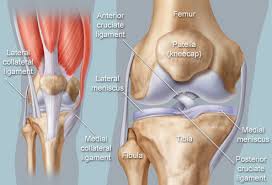Remedial Massage and Knee Pain
By Edward John Fearn
Knee pain can literally stop us in our tracks. When we lose the ability to move around the way we used to it can really affect our lives in so many ways. In some cases where there is extensive ligament damage or severe degenerative arthritis, surgery may in fact be required. However even if there is; some ligament damage, or arthritic type degeneration, that in itself may not be the direct cause of your knee pain. It is possible that active trigger points or knots in the muscles around your knee may actually be the cause of your pain.
Knowing which specific area around our knee that we are experiencing the pain can give us clues as to the possible cause of our problem.
For example;
- Pain in the inner part of the knee may be caused by a weakened vastus medius muscle, in conjunction with an overly tight vastus lateralis. This muscle imbalance can pull the knee out to the side resulting in knee pain. Myofascial dry needling can be used to wake up the weakened muscle as well as resolving any associated active trigger points. At the same time the use of deep remedial massage can assist in releasing the overly tight vastus lateralis muscle. Another muscle group associated with medial knee pain are the adductor muscles. Again ones goal is to release active trigger points or knots in the region.
- With outer knee pain, the most common culprit is an overly tight “illiotibial band” or ITB for short. As well as regular professional remedial massage therapy, the use of a foam roller for self massage at home is invaluable for resolving ITB problems. With outer knee pain is also worthwhile to look for active trigger points in the vastus lateralis muscle as well.
- For pain in the front part of the knee active trigger points in the rectus femoris muscle are often to blame, again myofascial dry needling or remedial trigger point massage should resolve this problem given time.
- Pain in the back of the knee can be caused by active trigger in the muscles situated directly over the back of the knee such as popliteus or the plantaris muscle. Alternatively we find that active trigger points in the hamstrings are sometimes to blame, or in some cases even trigger points in muscles of the lower leg such as gastronemius or soleus could be the source of the problem.
Remedial massage therapy and myofascial dry needling used together in combination for the treatment knee pain is a safe, effective and non-invasive way of resolving this common problem.
______________________________________________________________________________________________________
Remedial Massage and Sciatica
More than a few people find sciatica a pain in the butt, or a least that’s one of the more common symptoms. For someone suffering with sciatica pain is usually experienced in the lower back with pain radiating down into the leg. In most cases this pain is only experienced in one side of the body only.
Sciatica is caused by pressure or irritation affecting the sciatic nerve or one of its branches. It is often associated with issues related to the lower lumber to sacral vertebra. The Sciatic nerve itself is quite massive. In fact it is literally the largest and widest nerve in the entire body. It starts in the lower back, goes down through the buttocks then all the way down to the lower leg on both sides. One particular muscle situated quite deep within the buttocks called the piraformis sits directly over the sciatic nerve in most people, and in certain individuals we find that the nerve actually passes threw the muscle itself. Often we find that in sciatica the piraformis muscle can put pressure on sciatic nerve exacerbating the symptoms overall even if the primary cause had originated at the lower vertebra. Piraformis syndrome is a ‘sciatica like condition’ that can also bring about a simular pattern of symptoms. Generally with less lower back involvement though.
Remedial massage can be used as part of the treatment strategy, however if it is used in conjunction with myofascial dry needling the treatment outcomes are significantly improved. Most cases of acute sciatica will settle within a twelve week period at any rate, however rapid spontaneous recovery is quite common with many clients seeing their symptoms disappearing completely in as little as three or four sessions. Light stretching of the lower back and piroformis muscle can help somewhat with symptoms and in many cases light exercise such as swimming can also assist in recovery.
For those people interested in an effective sciatica based exercise plan, a consultation with a physiotherapist and or an exercise physiologist would be highly advantageous.
Although sciatica is never a pleasant condition, the level of pain that is experienced can vary greatly on the individual. For those experiencing extremely high pain levels medication may be needed during this stage and in some rare cases an epidural anaesthetic is required for pain management.
In the majority of cases however a combination of remedial massage and myofascial dry needling can be an effective and beneficial treatment for alleviation and healing of sciatic type pain.



